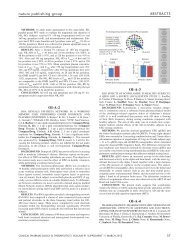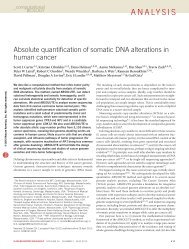open access: Nature Reviews: Key Advances in Medicine
open access: Nature Reviews: Key Advances in Medicine
open access: Nature Reviews: Key Advances in Medicine
You also want an ePaper? Increase the reach of your titles
YUMPU automatically turns print PDFs into web optimized ePapers that Google loves.
gene that encodes steroid 11β-hydroxylase<br />
and is regulated by adrenocorticotropic<br />
hor mone (ACTH)—and cod<strong>in</strong>g sequences<br />
from CYP11B2—a gene that encodes aldosterone<br />
synthase and is primarily regulated<br />
by angiotens<strong>in</strong> II. Expression of this hybrid<br />
gene leads to ACTH-regulated aldo sterone<br />
overproduction. 2 Glucocorticoids, <strong>in</strong> small<br />
doses, suppress hybrid gene expression<br />
and ameliorate primary aldosteronism and<br />
hypertension. Because wild-type CYP11B1<br />
is expressed <strong>in</strong> the zona fasciculata (ZF)<br />
of the adrenal cortex, so is the hybrid gene<br />
(Figure 1). Thus, aberrant aldosterone synthase<br />
activity, normally restricted to the<br />
zona glomerulosa (ZG), occurs <strong>in</strong> the ZF. In<br />
contrast to the ZG, which lacks the steroid<br />
17α-hydroxylase enzyme necessary for the<br />
formation of cortisol precursors, cortisol is<br />
available as a substrate for aldosterone synthase<br />
<strong>in</strong> the ZF. Hence, cortisol is converted<br />
<strong>in</strong>to the ‘hybrid steroids’ 18-hydroxycortisol<br />
and 18-oxocortisol, the levels of which are<br />
elevated <strong>in</strong> patients with FH-I. 2<br />
The second recognized form of familial<br />
hyperaldosteronism (FH-II) is neither<br />
gluco corticoid-suppressible nor associ ated<br />
with the hybrid gene mutation. 3 Approximately<br />
30% of patients with FH-II have<br />
uni lateral forms of primary aldosteronism<br />
(mostly due to an aldosterone-produc<strong>in</strong>g<br />
ade noma [APA]), with the rema<strong>in</strong>der<br />
be<strong>in</strong>g bilateral (due to bilateral adrenal<br />
hyper plasia [BAH]). The genetic basis of<br />
FH-II rema<strong>in</strong>s uncerta<strong>in</strong> and is almost certa<strong>in</strong>ly<br />
hetero geneous; several families have<br />
demon strated l<strong>in</strong>kage of FH-II with a locus<br />
at chromosome 7p22. 3<br />
In 2011, Mulatero and colleagues assessed<br />
prevalence rates of familial hyper aldo steronism<br />
among 300 patients consecutively<br />
diag nosed with primary aldosteronism,<br />
after exclud <strong>in</strong>g those suspected or diagnosed<br />
as hav<strong>in</strong>g a form of familial primary<br />
aldo steronism. 4 Hybrid gene test<strong>in</strong>g yielded<br />
only two (0.7%) patients with FH-I. Of<br />
the rema<strong>in</strong><strong>in</strong>g 298 study participants, 199<br />
had relatives available for and consent<strong>in</strong>g<br />
to bio chemical screen<strong>in</strong>g by aldosterone–<br />
ren<strong>in</strong> ratio (ARR) test<strong>in</strong>g and, where positive,<br />
def<strong>in</strong>itive confirmation or exclusion<br />
of primary aldo steronism by sal<strong>in</strong>e <strong>in</strong>fusion<br />
test<strong>in</strong>g. This analysis revealed that 12<br />
patients had at least one affected relative,<br />
result <strong>in</strong>g <strong>in</strong> a preva lence of FH-II of at least<br />
6% (almost 10-fold that of FH-I). The prevalence<br />
could be higher, as another 54 patients<br />
were classified as hav<strong>in</strong>g ‘uncerta<strong>in</strong>’ status,<br />
either because not all family members<br />
with hypertension underwent ARR test<strong>in</strong>g<br />
or because test<strong>in</strong>g of family members<br />
was <strong>in</strong>conclusive. 4<br />
In a major breakthrough towards further<br />
understand<strong>in</strong>g the genetic basis of primary<br />
aldosteronism, Choi and col leagues<br />
reported somatic mutations (Gly151Arg and<br />
Leu168Arg) <strong>in</strong> KCNJ5, which encodes an<br />
<strong>in</strong>wardly-rectify<strong>in</strong>g K + channel, <strong>in</strong> eight of 22<br />
patients with APA. 5 A third, germl<strong>in</strong>e mutation<br />
<strong>in</strong> KCNJ5 (Thr158Ala) had pre viously<br />
been identified <strong>in</strong> affected members of a<br />
US family with a new familial form of primary<br />
aldosteronism (FH-III). 6 The affected<br />
father and two daughters demon strated<br />
very severe primary aldo steronism, with<br />
childhood-onset hyper tension, hypo kalemia<br />
and markedly elevated aldosterone and<br />
sup pressed ren<strong>in</strong> levels. As <strong>in</strong> patients with<br />
FH-I, 18-hydroxycortisol and 18- oxocortisol<br />
levels were elevated, albeit to a greater<br />
degree. How ever, the primary aldosteronism<br />
was not glucocorticoid-suppressible, and<br />
the hybrid gene mutation was not present.<br />
Resected adrenal glands showed marked,<br />
diffuse hyperplasia of the ZF, with the comb<strong>in</strong>ed<br />
weight of both adrenal glands <strong>in</strong> one<br />
daughter reach<strong>in</strong>g 81 g (normal








